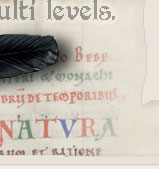Aaron, and list members:
Decoding classical Greek texts can follow two paths. The first transliterates the ancient language information. Philology scholars are often needed on this level. The second path can pull out the math information and translate the information in a validated historical context.
For example, the 300 BCE Hibeh Papyrus reported Greek festivals practiced living in Egypt.
http://planetmath.org/encyclopedia/HibehPapyrus.htmlNote that festival days were recorded in two systems. The first cited an Egyptian calendar data. The second pointed out a well known astronomical date ... ie. a summer or winter solstice, or a spring or fall equinox. Classical Greek calendars were connected to the local geographical setting (by selecting. the proper latitude) and/or local cultural context, fun aspects of the project.
The language side of the text was not difficult to transliterate.. The festival date encoding method also was not difficult either. Oddly, few scholars have spent much time with the text. About 15 years ago David Fowler passed along his 1983 analysis of the text. This year, honoring the untimely passing of Fowler, an update of the Hibeh Papyrus was posted to Academia.edu.
Hibeh Papyrus math scaled hours in a scaled n/45 table. Not all n/45 table members were listed. My analysis discussed a complete n/45 table in the context of Greek festivals, some of which coincided with traditional Greek festivals.
Transliterating and translating an ancient Greek text were fun for two reasons. The first allowed the linguist, or computer program, to jump back in time, in this case 300 BCE. The second requires decoders to report ancient arithmetic in modern arithmetic. Hopefully my paper meets both objectives.
Best Regards,
Milo Gardner







